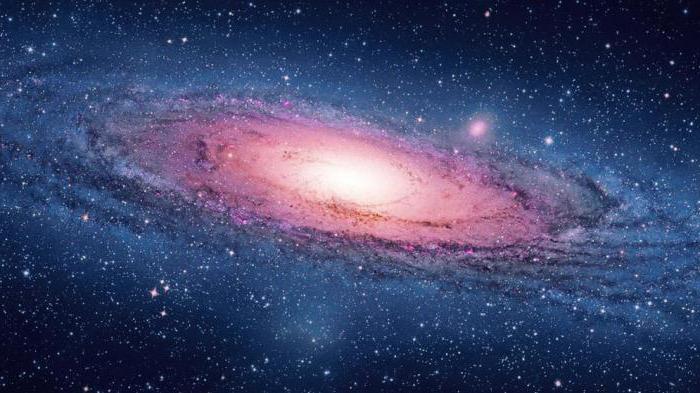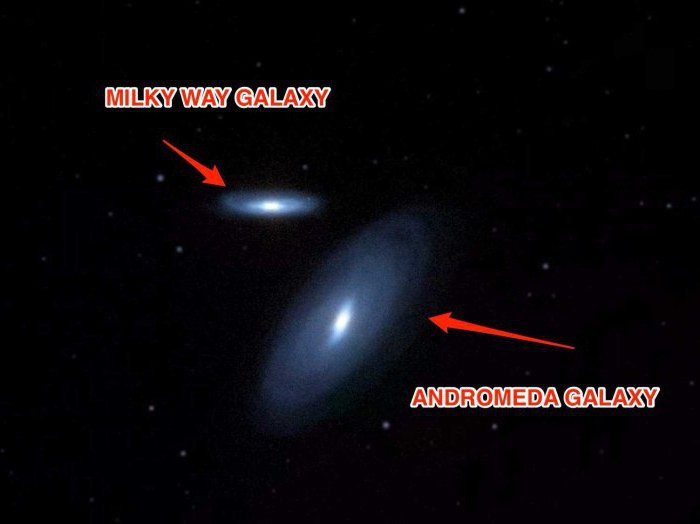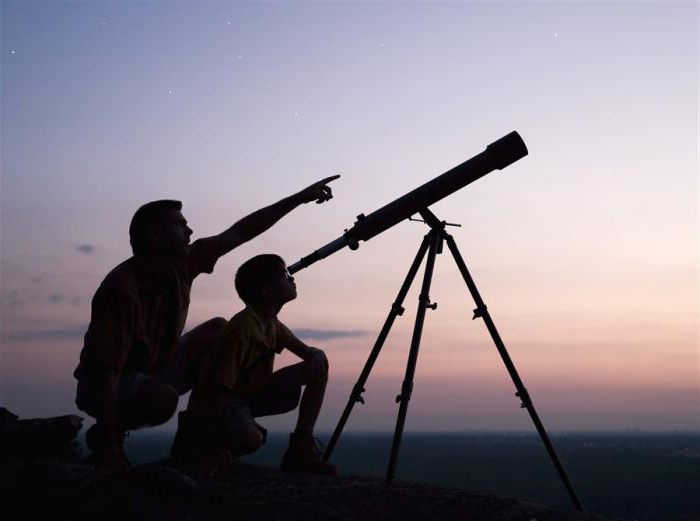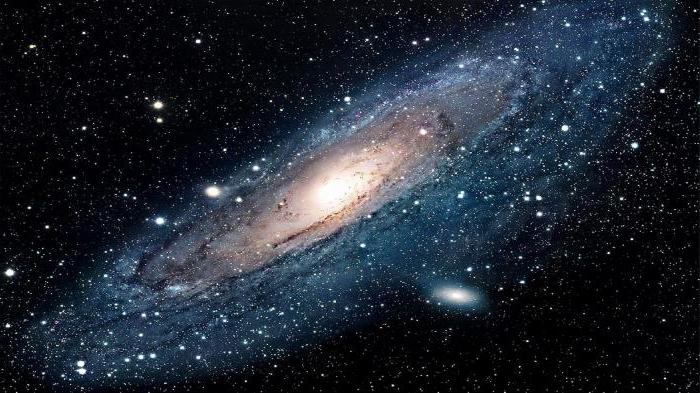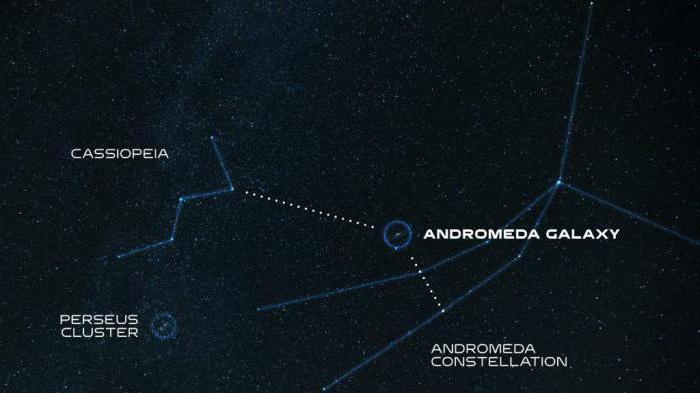What will happen when the Milky Way and Andromeda collide
→As is known, galaxies unite into clusters. The group of galaxies that includes, for example, the Milky Way is called the Local Group and includes about 30 galaxies. The two largest of these are the aforementioned Milky Way and the Andromeda Galaxy, or M31. These two and other galaxies orbit the center of mass of the Local Group. The width of the Milky Way disk is approximately 100 thousand light years. Two satellite galaxies of the Milky Way can be seen with the naked eye from the Southern Hemisphere - these are the Large and Small Magellanic Clouds, named after the 16th-century Portuguese traveler Ferdinand Magellan, who was the first inhabitant of the Northern Hemisphere to see them in the starry sky. These galaxies appear as two bright fuzzy spots, but they are made up of billions of stars. The Large Magellanic Cloud is located at a distance of 170 thousand light years from us, the Small Magellanic Cloud is at a distance of 190 thousand years. These are irregular galaxies located near ours, they look fragmented and deformed. At the boundaries of the group there are a number of isolated, smaller galaxies. The largest of them is the Triangulum Galaxy, or TGG. The Local Group itself is one of many galaxy clusters that make up the Virgo Supercluster.
It is believed that in 3 billion years the two aforementioned large galaxies - Milky Path and Andromeda collide. They will merge into one large galaxy, possibly elliptical. The Milky Way and Andromeda are now approaching each other, moving at a speed of 300 km/s relative to the Sun. Because angular velocity The Andromeda galaxy is unknown, scientists cannot say exactly when this collision will happen, and whether it will happen at all. Perhaps the galaxies will just move closer to each other.
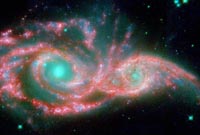 The collision hypothesis was put forward in 1959, but only recently, thanks to computer modeling, scientists were able to understand what this process would look like. Andromeda and the Milky Way from afar resemble the galaxies NGC 2207 and 1C 2163. Over time, they will look similar to the Antennae galaxy, although with some differences. These two clusters would move away from each other until, under the influence of the force of mutual attraction, they began to approach and eventually collide. The result would be a cluster of new stars and very massive black holes at the centers of both galaxies, which would eventually merge into one, forming an elliptical galaxy. This new galaxy, which is likely to form in the future, has been named Milkomeda. By using mathematical models we can even determine its shape.
The collision hypothesis was put forward in 1959, but only recently, thanks to computer modeling, scientists were able to understand what this process would look like. Andromeda and the Milky Way from afar resemble the galaxies NGC 2207 and 1C 2163. Over time, they will look similar to the Antennae galaxy, although with some differences. These two clusters would move away from each other until, under the influence of the force of mutual attraction, they began to approach and eventually collide. The result would be a cluster of new stars and very massive black holes at the centers of both galaxies, which would eventually merge into one, forming an elliptical galaxy. This new galaxy, which is likely to form in the future, has been named Milkomeda. By using mathematical models we can even determine its shape.
The collision of the Milky Way and Andromeda should occur in 3 billion years. By then, the gas content of these galaxies will be low, and as a result, not as many new stars will be formed as one might expect. Milkomeda will become a giant elliptical galaxy, but the density of its center will be much less than usual. Perhaps only Milcomeda and its satellite galaxies will remain from the Local Group. Most likely, after the collision, our Sun will end up in the galactic halo of Milkomeda. In 3 billion years, the Sun will be on the main sequence. According to evolutionary models, life on Earth will disappear by then, since the Sun will shine much brighter than it does now.
Screenshot from the application
Space, endless and majestic space... How many mysteries lurk in its depths? Probably, a person will never solve even half of them. Our Solar System is just a particle in an infinite number of star clusters - Galaxies, cradles of stars and planetary systems. They slowly float across the endless expanses of the Universe. Sometimes it happens that the paths of galaxies cross. Then clashes of truly grandiose proportions occur.
Collisions on a universal scale
When galaxies collide, energy emissions occur of such force that it is difficult to comprehend. As a result of such events, the Galaxies that merged into one begin to glow with even greater intensity.
The collision of galaxies is an incredibly long process, given the size of these cosmic objects. It can take millions or even billions of years. Naturally, scientists will never be able to observe the process from beginning to end. Therefore, it comes to the aid of astronomers Computer Engineering. Modern computers allow you to recreate a process accelerated thousands and thousands of times.
Galactic collisions on the monitor screen
An interactive 3D collision of two galaxies allows each of us to look at the collision process.
You can watch two galaxies collide. At the same time, gravity attracts their cores, which are most often black holes, and they begin their cosmic dance. At the same time, some star systems are thrown out of the region and they begin their lonely journey through the vastness of space. In the program, star systems are represented by colored dots.
How to use
The mouse is used to navigate the program. Moving it in the application window changes the angle, and rotating the wheel allows you to change the scale. Clicking the mouse button resets the simulation. The process begins again.
This small program makes you wonder what will happen to our world when, in three billion years, the Milky Way and the Andromeda Nebula cross, rushing towards each other? Will we end up on the outskirts of the Universe as a lonely wandering Solar System? Or will our sky light up with new stars? And will there even be people on our Earth by that time who will notice this?
And finally, a computer simulation of a collision with real photographs as examples.
Astronomers using the Hubble Space Telescope tried to more accurately determine the time of the collision of two galaxies - the Milky Way and the Andromeda Nebula.
The Andromeda nebula and the Milky Way are gradually moving closer to each other under the influence of mutual attraction, and scientists expect that in about four billion years the process of their merger will begin. And in another two billion years they will look like one galaxy, the BBC reports.
The likelihood that such cosmic processes could somehow pose a danger to the Sun and its surrounding planets is very small.
After the merger of galaxies, the night sky from Earth will look quite breathtaking - if, of course, billions of years from now there will still be anyone from the human race on our planet who can admire the night sky.
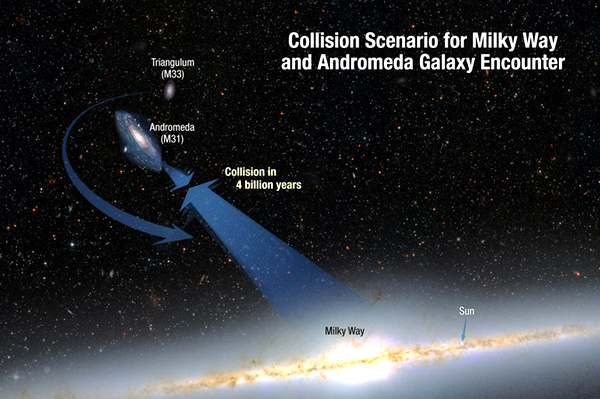
“Today the Andromeda Galaxy looks like a small, fuzzy object from Earth. Astronomers first looked at it more than a thousand years ago, says Roland van der Marel of the Space Telescope Science Institute in Baltimore.
“There are few things that occupy people’s minds more than issues related to space. And we can predict that this small fuzzy object could one day devour our Sun and the entire solar system,” the astronomer adds.
Transverse travel speed
It has long been known that these two galaxies are moving towards each other.
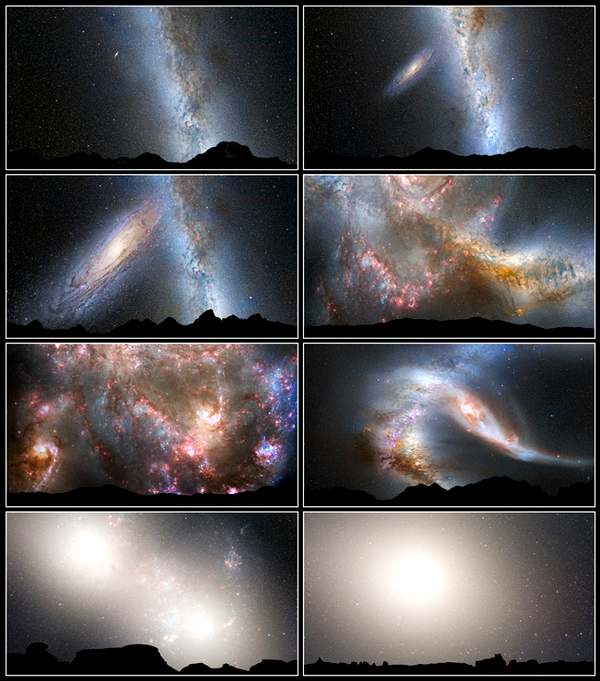
Estimated view of this cosmic event from the ground
- First row from left: Present day.
- First row, right: In 2 billion years, the disk of the Andromeda galaxy will get noticeably closer.
- Second row from left: In 375,000,000 years, Andromeda fills the field of view.
- Second row, right: 385,000,000 years from now, the sky is ablaze with new star formation.
- Third row, left: 3.9 billion years later, star formation continues.
- Third row, right: After 4 billion years, Andromeda is stretching and the Milky Way is becoming swollen.
- Fourth row, left: 5.1 billion years later, the cores of the Milky Way and Andromeda appear as a pair of bright petals.
- Fourth row, right: After 7 billion years, the merged galaxies will form a huge elliptical galaxy, its bright light will dominate the night sky.
The distance between them is approximately 2.5 million light years, and they are approaching each other at a speed of 400 thousand km/hour.
“We need to know not only how Andromeda is moving towards our galaxy, but also what the lateral velocity is, because this will help us understand whether Andromeda will pass us by or whether it is heading straight towards us,” says van der Marel.
“Astronomers have been trying to measure transverse velocity for a century. However, it was not possible to achieve success, because all the technologies available at that time did not allow this to be done. And for the first time, using the capabilities of the Hubble Space Telescope, we were able to measure this speed, which is also called “proper motion,” says Marel.
Created by specialists from the Space Telescope Science Institute, it shows how two galaxies merge to form one elliptical galaxy.
However, during the process of merging two galaxies, collisions of stars should not occur, since the distance between them is quite large.
However, as the researchers are sure, as a result of the ongoing movements, the location will also change solar system.
Scientists, based on their observations, say that Andromeda's small satellite - M33 (Triangulum Galaxy) - will also be involved in the merger process.
Photo: NASA; ESA; Z. Levay and R. van der Marel, STScI; T. Hallas, and A. Mellinger
Astronomy is an amazingly fascinating science that reveals to inquisitive minds all the diversity of the Universe. There are hardly people who, as a child, would never watch the scattering of stars in the night sky. This picture looks especially beautiful in the summer, when the stars seem so close and incredibly bright. In recent years, astronomers around the world have been particularly interested in Andromeda, the galaxy closest to our home Milky Way. We decided to find out what exactly attracts scientists about it and whether it can be seen with the naked eye.
Andromeda: brief description
The Andromeda Galaxy, or simply Andromeda, is one of the largest. It is approximately three to four times larger than our Milky Way, where the Solar System is located. It contains, according to preliminary estimates, about one trillion stars.
Andromeda is a spiral galaxy; it can be seen in the night sky even without special optical devices. But keep in mind that the light from this star cluster takes more than two and a half million years to reach our Earth! Astronomers say we now see the Andromeda Nebula as it was two million years ago. Isn't this a miracle?
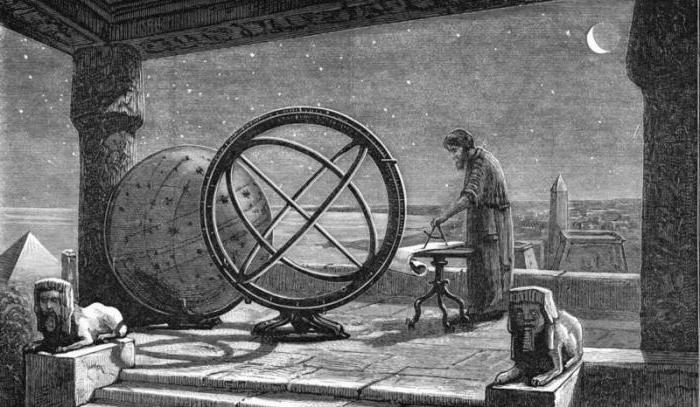
The Andromeda Nebula: from the history of observations
Andromeda was first spotted by an astronomer from Persia. He cataloged it in 1946 and described it as a hazy glow. Seven centuries later, the galaxy was described by a German astronomer who observed it over time using a telescope.
In the mid-nineteenth century, astronomers determined that Andromeda's spectrum was significantly different from previously known galaxies, and suggested that it consisted of many stars. This theory completely justified itself.
The Andromeda Galaxy, photographed only at the end of the nineteenth century, has a spiral structure. Although at that time it was considered just a large part of the Milky Way.
Structure of the galaxy
With the help of modern telescopes, astronomers were able to analyze the structure of the Andromeda Nebula. The Hubble telescope made it possible to see about four hundred young stars orbiting a black hole. This star cluster is approximately two hundred million years old. This structure of the galaxy quite surprised scientists, because until now they had not even imagined that stars could form around a black hole. According to all previously known laws, the process of condensation of gas before the formation of a star is simply impossible under the conditions of a black hole.
The Andromeda nebula has several satellite dwarf galaxies; they are located on its outskirts and could end up there as a result of absorption. This is doubly interesting due to the fact that astronomers are predicting a collision between the Milky Way and the Andromeda Galaxy. True, this phenomenal event will not happen soon.
The Andromeda Galaxy and the Milky Way: moving towards each other
Scientists have been making certain predictions for quite some time, observing the movement of both stellar systems. The fact is that Andromeda is a galaxy that is constantly moving towards the Sun. At the beginning of the twentieth century, an American astronomer was able to calculate the speed at which this movement occurs. This figure, three hundred kilometers per second, is still used by all astronomers around the world in their observations and calculations.
However, their calculations differ significantly. Some scientists claim that the galaxies will collide only in seven billion years, but others are confident that the speed of Andromeda’s movement is constantly increasing, and a meeting can be expected in four billion years. Scientists do not exclude a scenario in which, in a few decades, this predicted figure will once again decrease significantly. IN currently However, it is generally accepted that a collision should not be expected earlier than four billion years from now. What does Andromeda (galaxy) threaten us with?
Collision: what will happen?
Since the absorption of the Milky Way by Andromeda is inevitable, astronomers are trying to simulate the situation in order to have at least some information about this process. According to computer data, as a result of absorption, the solar system will be on the outskirts of the galaxy, it will fly over a distance of one hundred and sixty thousand light years. Compared to the current position of our solar system towards the center of the galaxy, it will move away from it by twenty-six thousand light years.
The new future galaxy has already received the name Milkyhoney, and astronomers claim that due to the merger it will be younger by at least one and a half billion years. In this process, new stars will form, which will make our galaxy much brighter and more beautiful. She will also change shape. Now the Andromeda Nebula is at a certain angle to the Milky Way, but during the merger process the resulting system will take on the shape of an ellipse and become more voluminous, so to speak.
The fate of humanity: will we survive the impact?
What will happen to people? How will the meeting of galaxies affect our Earth? Surprisingly, scientists say that there is absolutely no way!!! All changes will be expressed in the appearance of new stars and constellations. The map of the sky will completely change, because we will find ourselves in a completely new and unexplored corner of the galaxy.
Of course, some astronomers leave an extremely insignificant percentage of negative developments. In this scenario, the Earth could collide with the Sun or another stellar body from the Andromeda galaxy.
Are there planets in the Andromeda Nebula?
Scientists regularly search for planets in galaxies. They do not give up attempts to discover in the vastness of the Milky Way a planet similar in characteristics to our Earth. At the moment, more than three hundred objects have already been discovered and described, but all of them are located in our star system. In recent years, astronomers have begun to take an increasingly closer look at Andromeda. Are there any planets there at all?
Thirteen years ago, a group of astronomers, using a new method, hypothesized that one of the stars in the Andromeda Nebula hosts a planet. Its estimated mass is six percent of the largest planet in our solar system - Jupiter. Its mass is three hundred times the mass of the Earth.
At the moment, this assumption is at the testing stage, but has every chance of becoming a sensation. After all, until now astronomers have not discovered planets in other galaxies.
Preparing to search for a galaxy in the sky
As we have already said, even with the naked eye you can see a neighboring galaxy in the night sky. Of course, for this you need to have some knowledge of astronomy (at least know what the constellations look like and be able to find them).
In addition, it is almost impossible to see certain clusters of stars in the night sky of the city - light pollution will prevent observers from seeing at least anything. Therefore, if you still want to see the Andromeda Nebula with your own eyes, then go to the village at the end of summer, or at least to a city park, where there are not many streetlights. The best time The month for observation is October, but from August to September it is quite clearly visible above the horizon.
Andromeda Nebula: search scheme
Many young amateur astronomers dream of finding out what Andromeda really looks like. The galaxy in the sky resembles a small bright spot, but you can find it thanks to bright stars which are located nearby.
The easiest way is to find Cassiopeia in the autumn sky - it looks like the letter W, only more elongated than it is usually denoted in writing. Usually the constellation is clearly visible in the Northern Hemisphere and is located in the eastern part of the sky. The Andromeda Galaxy lies below. To see it, you need to find a few more landmarks.
They are three bright stars below Cassiopeia, they are elongated in a line and have a red-orange hue. The middle one, Mirak, is the most accurate reference point for novice astronomers. If you draw a straight line upward from it, you will notice a small luminous spot that resembles a cloud. It is this light that will be the Andromeda galaxy. Moreover, the glow that you can observe was sent to Earth even when there was not a single person on the planet. Amazing fact, isn't it?
G. NIKOLAEV. Based on materials from the magazine “Bild der Wissenschaft”.
This grandiose phenomenon plays a big role in the evolution of the Universe
Colliding galaxies is a slow process. To see it, it is not enough to have only a telescope. Computers can simulate this phenomenon by varying masses, speeds, and the nature of the interaction - tangential contact or frontal impact.

![]()
The galaxy NGC 7252. Visible inside it is a globular cluster and a small - only 10,000 light-years in diameter - spiral formation (bottom left). This is evidence that NGC 7252 came from a merger with some other galaxy.
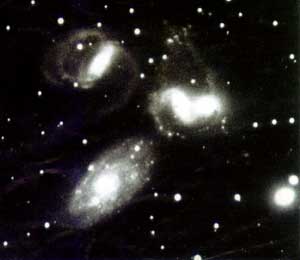
In a group of galaxies called the Stephens Quintet (NGC 7317, 7318, 7319 and 7320), two galaxies have merged, and a third will soon join them.
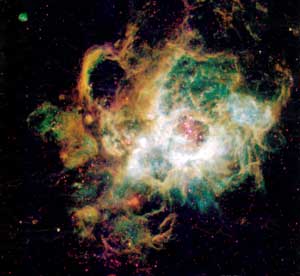
The huge, 1,500 light-years-long gas cloud NGC 604 in the M33 galaxy recently gave birth to about 200 hot giant stars. This is one of the important processes in the evolution of the galaxy.
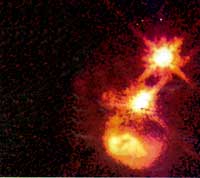
In recent years, astronomers have observed more and more examples of collisions between a galaxy belonging to a quasar and neighboring galaxies. Tidal forces push huge masses of gas into the quasar's black hole - “feeding” it.
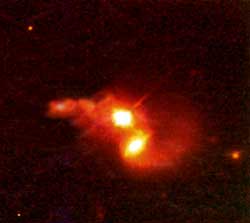
The merger of two spiral galaxies lasts for one hundred million years - this is the initial stage of the formation of an elliptical system. Merger is accompanied by birth
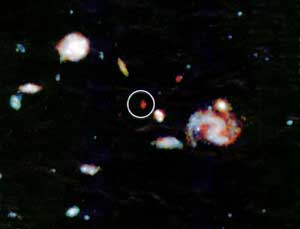
The most distant source of light from us. Hubble Telescope and for 10 days in a row I photographed this small section of the sky in the constellation Ursa Major.
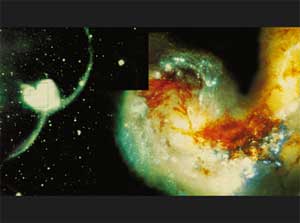
In a telescope standing on the ground, the galaxies NGC 4038 and NGC 4039 linked to each other are visible in this position. And on the right, in the image taken by the Hubble orbital telescope, the cores of these colliding star systems are visible.
Two fiery wheels roll towards each other silently and majestically. They consist of myriads of stars involved in a grandiose round dance. When they get close, an invisible force will destroy this cosmic dance. The rotating stellar spirals will engage one another, like the gears of a giant machine, slow down in their movement, and the glow will begin. Yes, such that billions of years later, astronomers, millions of light years away from the site of the event, will peer at this picture with surprise.
The collision of galaxies - huge cosmic objects - occurs with unimaginable force: energy is released and masses move in quantities beyond any imagination.
There is a very low probability that individual stars will collide or collide, since, as a rule, they are separated from each other at distances hundreds of millions of times greater than their diameter. While the gaps between galaxies exceed the size of these stellar islands only by tens and hundreds of times. Therefore, the collision of galaxies is many times more likely than that of individual stars.
Sometimes a dwarf galaxy simply pierces a large stellar spiral. The invading galaxy, passing through the spiral, attracts its individual stars. As a result, when the dwarf leaves the large spiral, some of its stars form something like an annular corridor. Gas clouds remain in it, which serve as material for the birth of new stars.
The most famous of these objects is the galaxy called the “Carriage Wheel” in the constellation Sculptor. The Hubble Orbital Telescope recently discovered “tails” many thousands of light years long in its center. Apparently, this is molecular hydrogen colliding with gas clouds and therefore heated to one million degrees Celsius.
The interaction of galaxies of different shapes is known: spiral, elliptical and irregular, which either fly past each other at close distances, or engage one another, or even collide frontally. Moreover, the mutual gravitational force of such clusters often significantly changes them. appearance. This happens to about two percent of star systems located in space relatively close to Earth.
The closest pair of colliding stellar islands to us is in the constellation of the Raven at a distance of 63 million light years. This pair is NGC 4038 and NGC 4039, but they are better known to astronomers and astronomy enthusiasts as “Antenna” galaxies. The galaxies earned this name because gravity tore out long ribbons of gas and stars, shaped like the antennae of insects.
“Antennae formations are a clear case of galactic collisions and, moreover, an excellent teaching example for anyone who wants to understand this phenomenon,” says astronomer Francois Schweitzer from the Carnegie Institution in Washington. Schweitzer and his colleagues recently studied the convergence of these two star clusters using materials obtained by the Hubble telescope. The highly sensitive astronomical instrument discerns features in these galaxies up to 15 light-years in size. “Until recently, one could only dream of such opportunities. It’s like watching a collision between two cars,” comments Stefan E. Zepf from Yale University (USA).
Researchers have discovered more than a thousand newly formed globular star clusters in Antenna galaxies. Each of them contains up to a million suns. The age of the clusters is no more than hundreds of millions of years. They were formed under the influence of tidal forces excited by the convergence of the two systems.
The force of gravity does not play a determining role in the interaction between entire stellar islands. The effect of gravitational forces on individual parts of the galaxy is more significant. Two regions that are close together attract each other more strongly than regions that are far away. This is how tidal forces arise, which stretch the spiral of the galaxy or its circumference in length, bending them. All this happens even when star systems pass close to each other without colliding.
What happens when galaxies collide depends on both the geometry of the impact and the speed at which it occurs. At an approach speed of 200 kilometers per second, systems most often merge; at 600 kilometers per second, they pass through each other like two ghosts. And if the approach occurs at a speed of up to 1000 kilometers per second, the galaxies scatter to pieces.
The observational methods that astronomers were able to use previously were unable to detect the effects of violent galactic collisions. Only now, in 1998, two English astronomers - Neil Trentham and Baram Mobasher, using a telescope installed in Hawaii (its mirror diameter is 2.2 meters), discovered a lonely arc consisting of gas and stars. It stretches over 260 thousand light years and is located in a group of galaxies called Coma.
Astronomers suggest that this arc is part of some galaxy that was preserved after its meeting with its neighbor. In other cases, the “tails” or “whiskers” of galaxies stretched by tidal forces remain connected to the parent community of stars.
Tidal forces not only distort the shapes of galaxies, they move clouds of gas and dust, which, for example, in spiral systems account for up to 20 percent of their apparent mass. These clouds, condensing during the action of tidal forces, give birth to new stars. The process of birth of celestial bodies proceeds very quickly. The luminosity of the galaxy therefore increases many times over a few millions of years.
It turns out that cosmic collisions do not lead to the destruction of the inhabitants of the sky, but serve as a source of eternal youth for the cosmos, rejuvenating it.
In “Antenna” galaxies, astronomers were able to examine the details of the process of the appearance of star clusters. “The number of globular star clusters we saw was astonishing,” said astronomer Brad Whitmore of the Orbiting Telescope Institute in Baltimore. - Until now, we thought that globular clusters, both in our and other galaxies, consist of old stars. It turns out that this is not always the case. Understanding this fact should change our view of the later phases of stellar development, and will also affect the timing of various celestial events.”
Cosmic fountains observed near “Antenna” galaxies make it possible to more accurately determine the time of their beginning, development and collision. The following conclusion suggests itself: collisions of galaxies are one of the important factors in the life of the cosmos. In the past, there were many more interacting galaxies than there are today. The reason is probably that the Universe itself was much smaller star systems it was closer, and therefore they hit one another or touched many times more often.
Astronomers can now use telescopes to observe cosmic events that occurred during 90 percent of the entire age of the Universe. And this is an extremely interesting look into the past of space. This is possible due to the constancy of the speed of light. When astronomers see images of the most distant objects, they see inhabitants that were just born when the universe was created.
Star formation in the early Universe began approximately one billion years after the initial explosion and peaked one to two billion years later. Then it went ten times more energetic than we now observe in our Milky Way. Since then, the process has subsided, and the birth of stars is a rarity in space near us.
New discoveries strengthen the so-called hierarchical model of development. This means: at first, only small structures were formed, which then formed larger compounds. Stellar associations began to cluster before galaxies emerged. From them, under the influence of the combined force of gravity, galaxy clusters were formed.
Professor Simon White from the Institute of Astrophysics in Garching is convinced that the birth of galaxies was a long process. He criticizes the still prevailing idea that galaxies arose at an early time, during the collapse of a huge primordial cloud.
According to these views, elliptical galaxies should have arisen soon after the initial explosion from a gaseous non-rotating cloud. And later a short time massive stars formed and then exploded as supernovae. Since the “raw” material - gas - was quickly consumed, the conditions for the birth of new stars disappeared. Therefore, the old hypothesis considered elliptical galaxies to be very ancient.
These hypotheses were questioned back in the seventies by the brothers Alar and Yuri Thumre (Germany). They showed that the computer programs they compiled consistently drew elliptical galaxies resulting from the merger of two or more spirals.
Most astronomers then did not pay much attention to the conclusions made by the Thumre brothers. The exception was Francois Schweitzer. He explored the galaxy NGC 7252, located 300 million light years away from us. She has two large trains. At the center of the galaxy there is a disk rotating in the direction opposite to the movement of stars located close to the disk, but outside it. And the stars located on the periphery of this galaxy rotate in the same direction as the central disk. Schweizer explained all this by saying that the NGC 7252 system is the product of a collision of two galaxies that merged into one system about a billion years ago.
The fact that elliptical galaxies are not the most ancient systems in the Universe is also supported by the fact that galaxy clusters billions of light years away from us are composed primarily of spiral galaxies. Clusters located closer to us contain mainly elliptical galaxies. Some of them are among the greatest in space. Perhaps, in the course of their lives over billions of years, they “swallowed” dozens of other galaxies?
New evidence about the time of birth of spiral and elliptical galaxies was recently proposed by Stefan Zepf. He analyzed images of distant star fields taken by the Hubble Telescope and many infrared images taken by ground-based telescopes. Conclusion: elliptical galaxies are much less common in distant regions of space than could be expected if we adhere to the old ideas about their great age. Zepf concluded: “Either the ellipses arose later and the formation of stars in them is hidden from us by a large mass of dust accumulated in their vicinity, or they received their shape due to mergers with small galaxies.”
But scientists learn not only about the past by studying traces of past impacts. Antenna galaxies give us today an idea of what may happen in the future to the Milky Way. Now our star system and the Andromeda nebula are rushing towards each other. They are now separated by 2.9 million light years, and the speed of approach is 300 kilometers per second. One can only guess what will happen in three billion years: either an impact will follow, or the galaxies will fly close to each other. For a reliable forecast, it is necessary to study the direction of movement of both galaxies properly and with great accuracy. But even if there is no collision and they just pass each other at close range, mutual attraction will force the galaxies to change trajectories. It is possible that they will then merge and give birth to a new elliptical system.
This will happen when our Sun is already a dying star. But in the sky above the dead Earth, newly born globular clusters of stars will sparkle, and perhaps astronomers, whose curiosity is boundless, will find shelter on some planet near them.

